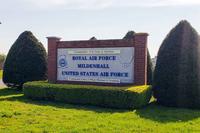Defense Secretary Chuck Hagel said Thursday that the U.S. would match the threat escalation from North Korea with escalating readiness for retaliation.
"We will be prepared, we have to be prepared, to deal with any eventuality there," Hagel said of the B52 and B2 stealth bomber overflights of the peninsula the U.S. has conducted, the buildup of missile defenses in Alaska, and the new pact just signed with South Korea on a joint response to aggression from the North. "We don’t have any choice," Hagel said.
The U.S. actions were not meant to be provocative, Hagel said, but the series of threats from the 28-year-old North Korean "Supreme Leader" king Jong-un had "ratcheted up the danger" to South Korea, the 28,500 U.S. troops stationed there, and other U.S. allies in the region.
"We have to take seriously every provocative, bellicose word and action that this new young leader has taken so far" since coming to power last year with the death of his father, Kim Jong-il, Hagel said. "We, the U.S. and South Korea, have not been involved in provocating (sic) anything," he said.
Hagel’s message was backed up at the White House, where principal deputy Press Secretary Josh Earnest said that "in the face of the bellicose rhetoric and threats that have been emanating from the North Koreans, we stand shoulder to shoulder with our allies in South Korea to ensure that their -- that the interests of the United States and the allies of the United States remain protected."
U.S. intelligence was caught off guard last year by North Korea’s successful launch of a satellite, followed earlier this year by the underground testing of a nuclear weapon. As the North improves its long-range missiles, the U.S. "homeland can’t be considered a sanctuary," said Army Gen. Martin Dempsey, who joined Hagel at a Pentagon briefing.
Earlier this month, Hagel announced that the U.S. would be spending $1 billion to add 14 interceptors to the 26 already in place at Fort Greely, Alaska, as part of the missile defense system against long-range strikes from North Korea. The U.S. also has four interceptors at Vandenberg Air Force Base, Calif.
In its strongest message to date to the North, the U.S. on Thursday sent two Air Force B2 Spirit nuclear-capable stealth bombers on a flyover of the peninsula.
The batwing aircraft dropped two dummy bombs on South Korea’s Jik Do range as part of the ongoing Foal Eagle training exercise to demonstrate "the United States’ ability to conduct long-range precision strikes quickly and at will," U.S. Forces-Korea said in a statement.
The aircraft flew about 13,000 non-stop miles on the "extended deterrence mission" from Whiteman Air Force Base, Mo., to South Korea and back in what was believed to be the first use of stealth bombers in the Korean theater. In an earlier show of force, B52 bombers made overflights but did not drop any munitions.
Last week, Army Gen. James Thurman, head of the Combined Forces Command in South Korea, and Gen. Jung Seung-jo, chairman of the South Korean Joint Chiefs of Staff, signed a Combined Counter-Provocation plan.
"By completing this plan, we improved our combined readiness posture to allow us to immediately and decisively respond to any North Korean provocation," the two generals said in a statement.
The unusual and public moves by the allies were triggered by the even more unusual and provocative actions by the regime of Kim Jong-un.
The North recently cut off its military hotline to Seoul, warned of nuclear war, threatened U.S. bases in the region, announced that the 1953 armistice ending the Korean War was no longer in effect, and put out propaganda videos showing New York City and the U.S. Capitol in flames.
Despite the bellicose warnings, South Korean analysts noted that joint North and South Korean industrial complex at Kaesong on the North’s side of the De-Militarized Zone, which is a main source of hard currency for the North, remained in operation. About 500 workers from the South commuted to their jobs across the DMZ and returned without incident, according to South Korean news reports.
Several analysts have speculated that the threats from Kim were a method of shoring up his backing from his own military, and were also intended to test the new power lineup in the region. In China, the North’s main ally, Xi Jinping has just been installed as President, Prime Minister Shinzo Abe assumed office in Japan last September, and President Park Geun-hye became the first woman to lead South Korea last month.
At the Atlantic Council think tank, where Hagel was chairman before going to the Pentagon, defense analyst Ian Brzezinski said there were "few areas in the world where U.S. readiness is as high" as it is on the Korean peninsula.
But "it’s prudent for the U.S. government to move assets" to bolster defenses against North Korean threats "not only to the region but to the homeland defense of the U.S.," said Brzezinski, a former Defense Department and White House aide.





























